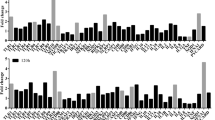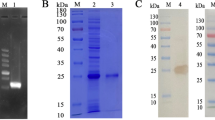Abstract
Th1 and Th2 cytokine gene expression in buffalo calves during primary infection with Fasciola gigantica as well as in response to immunization with the parasite recombinant fatty acid binding protein (rFABP) and recombinant glutathione S-transferase (rGST) proteins was measured at 14th week of infection by real-time PCR with the double-stranded DNA-binding dye SYBR Green. Experimental animals were randomly distributed into FABP, GST, cocktail, challenge and healthy groups. Animals in groups FABP and GST were immunized with 400 μg rFABP and rGST, respectively, and cocktail group with a mixture of 400 μg each of rFABP and rGST in the neck and thigh muscles. All animals received three immunizations at 3-week interval. Calves were challenged per os with 400 viable metacercariae along with the unimmunized challenge control group 1 month after the last immunization. Expression of various cytokines in response to the immunization and parasite primary infection was measured by real-time PCR. Expression of IL-2 (4.5-fold) and IFN-γ (3.2-fold), followed by IL-6 (1.7-fold) and IL-4 (1.6-fold), with downregulation of TNF-α and IL-10 was observed in response to F. gigantica infection in these animals. However, there was a sharp increase in the expression of the IL-4 (211.93 and 111.81-fold) and IL-6 mRNA (219.22 and 48.29-fold) to GST and FABP immunizations, respectively. A downregulation of the IL-1α, a Th1 cytokine in response to FABP and GST immunization in these calves, was also observed. Overall, a mixed type of Th1 and Th2 cytokine environment was evoked to chronic F. gigantica infection and immunization with the above two recombinant proteins in buffaloes.


Similar content being viewed by others
References
Brady MT, O’Neill SM, Dalton JP, Mills KH (1999) Fasciola hepatica suppresses a protective Th1 response against Bordetella pertussis. Infect Immun 67:5372–5378
Buffoni L, Zafra R, Pérez-Ecija A, Martínez-Moreno FJ, Martínez-Galisteo E, Moreno T, Pérez J, Martínez-Moreno A (2010) Immune response of goats immunized with glutathione S-transferase and experimentally challenged with Fasciola hepatica. Parasitol Int 59(2):147–153
Clery DG, Torgerson P, Mulcahy G (1996) Immune responses of chronically infected adult cattle to Fasciola hepatica. Vet Parasitol 62:71–82
Devine C, Brennan GP, Lanusse CE, Alvarez LI, Trudgett A, Hoey E, Fairweather I (2011) Inhibition of triclabendazole metabolism in vitro by Ketoconazole increases disruption to the tegument of a triclabendazole-resistant isolate of Fasciola hepatica. Parasitol Res 109:981–995
Donnelly S, O’Neill SM, Sekiya M, Mulcahy G, Dalton JP (2005) Thioredoxin peroxidase secreted by Fasciola hepatica induces alternative activation of macrophages. Infect Immun 73:166–173
Donnelly S, Stack CM, O’Neill SM, Sayed AA, Williams DL, Dalton JP (2008) Helminth 2-Cys peroxiredoxin drives Th2 responses through a mechanism involving alternatively activated macrophages. FASEB 22:4022–4032
Dowling DJ, Hamilton CM, Donnelly S, Course JL, Brophy PM, Dalton J, O’Neill SM (2010) Major secretory antigens of the helminth Fasciola hepatica activate a suppressive dendritic cell phenotype that attenuates Th17 cells but fails to activate Th2 immune response. Infect Immun 78(2):793–801
El-Rahimy HH, Mahgoub AM, El-Gebaly NS, Mousa WM, Antably AS (2012) Molecular, biochemical, and morphometric characterization of Fasciola species potentially causing zoonotic disease in Egypt. Parasitol Res 11:1103–1111
Flynn RJ, Mulcahy G (2008) The roles of IL-10 and TGF-beta in controlling IL-4 and IFN-gamma production during experimental Fasciola hepatica infection. Int J Parasitol 38:1673–1680
Foster N, Elsheikha HM (2012) The immune response to parasitic helminths of veterinary importance and its potential manipulation for future vaccine control strategies. Parasitol Res 110:1587–1599
Golden O, Flynn RJ, Read C, Sekiya M, Donnelly SM, Stack C, Dalton JP, Mulcahy G (2010) Protection of cattle against a natural infection of Fasciola hepatica by vaccination with recombinant Cathepsin L1 (rFhCL1). Vaccine 28(34):5551–5557
Hoyle DV, Taylor DW (2003) The immune response of regional lymph nodes during the early stages of Fasciola hepatica infection in cattle. Parasite Immunol 25:221–229
Ingale SL, Singh P, Raina OK, Mehra UR, Verma AK, Gupta SC, Mulik SV (2008) Interferon-gamma and interleukin-4 expression during Fasciola gigantica primary infection in crossbred bovine calves as determined by real-time PCR. Vet Parasitol 152:158–161
Ingale SL, Singh P, Raina OK, Verma AK, Channappanavar R, Mehra UR (2010) Interleukin-2 and interleukin-10 gene expression in calves experimentally infected with Fasciola gigantica. Live Sci 131:141–143
Khalil SS, Abou SS, Rashwan EA (1999) Production of proinflammatory cytokines (GM-CSF, IL-8 and IL-6) by monocytes from fasciolosis patients. J Egypt Soc Parasitol 20:1007–1015
Konnai S, Usul T, Ohashi K, Onuma M (2003) The rapid quantitative analysis of bovine cytokine genes by real-time RT-PCR. Vet Microbiol 94:283–294
Kumar N, Varghese A, Gaurav N, Chandra D, Samanta S, Gupta SC, Adeppa J, Raina OK (2012) Vaccination of buffaloes with Fasciola gigantica recombinant glutathione S-transferase and fatty acid binding protein. Parasitol Res 110:419–426
Martínez-Valladares M, del Rosario FM, Fernández-Pato N, Castañón-Ordóñez L, Cordero-Pérez C, Rojo-Vázquez FA (2010) Efficacy of nitroxynil against Fasciola hepatica resistant to triclabendazole in a naturally infected sheep flock. Parasitol Res 107:1205–1211
Mas-Coma S, Bargues MD, Valero MA (2005) Fascioliasis and other plant-borne trematode zoonoses. Int J Parasitol 35:1255–1278
McManus DP, Dalton JP (2006) Vaccines against the zoonotic trematodes Schistosoma japonicum, Fasciola hepatica and Fasciola gigantica. Parasitology 133 (Suppl.): S43-S61
Molina EC (2005) Serum interferon gamma and interleukins-6 and -8 during infection with Fasciola gigantica in cattle and buffaloes. J Vet Sci 6:135–139
Molina EC, Skerratt LF (2005) Cellular and humoral responses in liver of cattle and buffaloes infected with a single dose of Fasciola gigantica. Vet Parasitol 131(1–2):157–163
Mulcahy G, Dalton JP (2001) Cathepsin L proteinases as vaccines against infection with Fasciola hepatica in ruminant. Res Vet Sci 70:83–86
Nambi PA, Yadav SC, Raina OK, Sriveny D, Saini M (2005) Vaccination of buffaloes with Fasciola gigantica recombinant fatty acid binding protein. Parasitol Res 97:129–135
Osman MM, Abo-El-Nazar SY (1999) IL-10, IFN-gamma, and TNF-alpha in acute and chronic human Fascioliasis. J Egypt Soc Parasitol 29(1):13–20
Raadsma HW, Kingsford NM, Suharyanta STW, Piedrafita D (2007) Host responses during experimental infection with Fasciola gigantica or Fasciola hepatica in merino sheep I. Comparative immunological and plasma biochemical changes during early infection. Vet Parasitol 143:275–286
Spithill TW, Smooker PM, Copeman DB (1999a) Fasciola gigantica, epidemiology, control, immunology, and molecular biology. In: Dalton JP (ed) Fasciolosis. CABI Publishing, Oxon, UK, pp 465–525
Spithill TW, Smooker PM, Sexton JL, Bozas E, Morrison CA, Parsons JC (1999b) The development of vaccines against Fasciola hepatic. In: Dalton JP (ed) Fasciolosis. CAB International, Wallingford, pp 377–410
Vukman KV, Adams PN, Metz M, Maurer M, O’Neill SM (2013) Fasciola hepatica tegumental coat impairs mast cells ability to drive Th1 immune responses. J Immunol 190:2873–2879
Waldvogel AS, Lepage MF, Zakher A, Reichel MP, Eicher R, Heussler VT (2004) Expression of interleukin-4, interleukin-4 splice variants and interferon gamma mRNA in calves experimentally infected with Fasciola hepatica. Vet Immunol Immunopathol 97:53–63
Zhang W, Moreau E, Peigne F, Huang W, Chauvin A (2005) Comparison of modulation of sheep, mouse, and buffalo lymphocyte responses by Fasciola hepatica and Fasciola gigantica excretory–secretory products. Parasitol Res 95:333–338
Zhang WY, Moreau E, Yang BZ, Li ZQ, Hope JC, Howard CJ, Huang WY, Chauvin A (2006) Humoral and cellular immune responses to Fasciola gigantica experimental infection in buffaloes. Res Vet Sci 80:299–307
Acknowledgments
The authors are thankful to the Department of Biotechnology, Government of India, New Delhi for providing grants to this research project. We are thankful to the Director, Indian Veterinary Research Institute, Izatnagar for providing necessary facilities for the research work. The first author is also thankful to IVRI for providing fellowship during PhD.
Author information
Authors and Affiliations
Corresponding author
Rights and permissions
About this article
Cite this article
Kumar, N., Raina, O.K., Nagar, G. et al. Th1 and Th2 cytokine gene expression in primary infection and vaccination against Fasciola gigantica in buffaloes by real-time PCR. Parasitol Res 112, 3561–3568 (2013). https://doi.org/10.1007/s00436-013-3540-y
Received:
Accepted:
Published:
Issue Date:
DOI: https://doi.org/10.1007/s00436-013-3540-y




